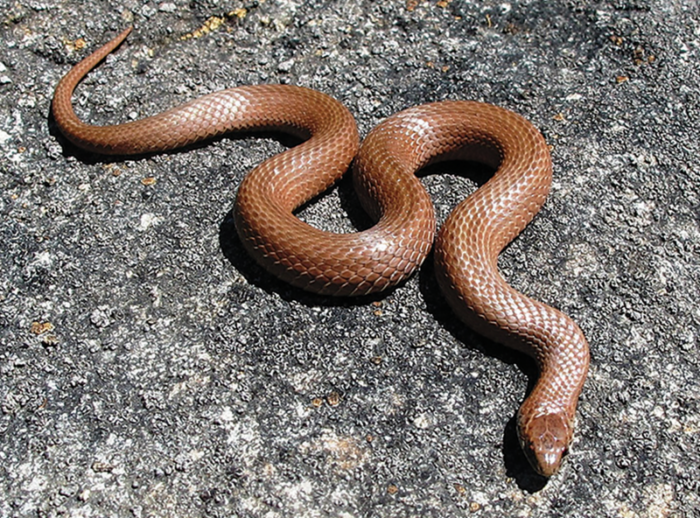By Molly Kirk/DWR
Photos by J.D. Kleopfer/DWR & Rick Reynolds/DWR
It’s spooky season, when things that slither and fly take a leading role in scary scenarios. Snakes and bats are some of the superstars of the strange, giving lots of people the “ick.” But is their bad rap deserved? Let’s find out…

A smooth earthsnake. Photo by J.D. Kleopfer/DWR
Should We Be Scared of Snakes?
It seems like people either love them or are creeped out by them, but honestly, snakes don’t really care. They’re just living their lives.
“I think that there are a lot of people that are afraid of snakes, and a large part of that has to do with a lack of understanding as to their role in the environment and misinterpretation of their behaviors,” said DWR Watchable Wildlife Biologist Meagan Thomas. “Also, they’re often represented in the media as being scary, dangerous creatures, which passes that misunderstanding on to the general public.
“Like so many different organisms, snakes play a really important role from both a predator perspective and a prey perspective,” Thomas continued about snakes. “They serve as meals for a lot of other species that I’m sure people really care about, like eagles and other birds and mammals. But then they also are regulating a lot of prey items, so things like insects, fish, or mice and rodents.”
Did you know? Some nonvenomous snakes (eastern milksnakes, black kingsnakes, and black racers) actually prey on other snakes, including venomous species.
There are 32 species of snake in Virginia, but only three are venomous (cottonmouth, copperhead, and timber rattlesnake). Of these, only the copperhead and timber rattlesnake occur in Southwest Virginia. Cottonmouths (aka water-moccasins) are primarily found in southeastern Virginia. Some of the more commonly encountered harmless (nonvenomous) snakes in Virginia include the eastern milksnake, northern ring-necked snake, eastern ratsnake (aka black snake), black racer, and northern watersnake, which is often misidentified as a cottonmouth.
Did you know? Only 15 deaths have been attributed to venomous snake bite in Virginia in the last 30 years, and many of these victims did not seek medical attention. More people are killed and/or injured by horses and dogs than snakes in the United States every year.
So, how aggressive are snakes? “A lot of times when people are getting bitten by snakes, it’s because they are putting themselves in the proximity of the animals, either intentionally or unintentionally,” said Thomas. “That can be like somebody intentionally going in and trying to relocate or kill the snake, and they get bit in the process. Or it can be when you’re gardening and there’s a snake there and you happen to not see it, right? But they’re definitely not an animal that I would describe as aggressive in any sense of the word. They can be defensive, for sure, but aggressive? No.”
So, basically, the best way to avoid negative interactions with snakes is to just leave them alone and abide by a “live and let live” philosophy. If you want to learn more about snakes in Virginia, check out DWR’s A Guide to the Snakes and Lizards of Virginia.

An eastern small-footed bat. Photo by Rick Reynolds/DWR
Should We Be Scared of Bats?
Bats also generate a less than positive reaction from many people, having been depicted in movies as the alternative physical manifestation of Dracula and flying fangs. “Any animal that is notoriously nocturnal is a little scary to some people. I also just think a lot of people view them kind of as flying rodents, right?” said Thomas. “People don’t really like mice either, and to a lot of people, bats are just flying mice.
“But the reality of the situation, is that they are another species that plays a really essential role when it comes to pest control,” Thomas said. “I lot of people don’t realize it, but bats can be considered pollinators as well.”
Did you know? Bats can eat up to 3,000 insects in a single night, almost as much as their body weight!
Many people associate bats with rabies. While bats can be rabies carriers, less than 1 percent of bats have rabies, so the odds of contracting rabies from a bat bite or scratch is minimal.
“Some people worry about bats flying into their hair,” Thomas said. “I think that’s because you see imagery when animals in a cave are roosting or sleeping during the day, and then they get disturbed by something and they’re flying everywhere. But they actually have a really incredible awareness of their surroundings, so they’re not going to be just flying into you.”
Did you know? Bats aren’t blind! Bats can see, and many species use eyesight and echolocation to navigate.
Just like snakes and most wildlife, it’s best to leave bats alone! Learn more about DWR’s Guide to Bats in Virginia.


